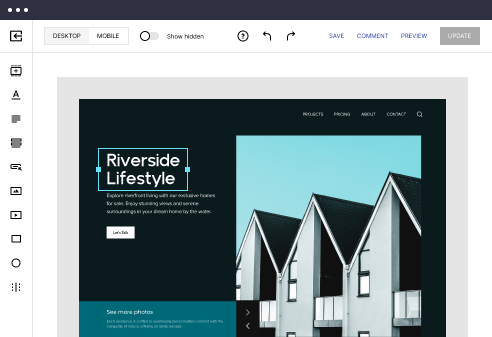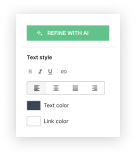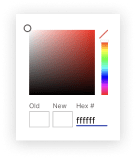
Next.js optimized unauthorized page template
Explore Similar TemplatesAbout template
Supercharge your unauthorized page with Next.js for outstanding performance! Learn more today.
Recommended templates
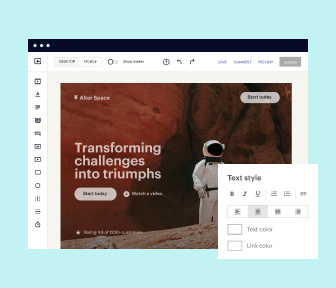
Easy to build without coding
With the intuitive drag-and-drop builder, anyone on your team can create high-converting pages without any knowledge of code or design. Make enhancements to your landing page with custom widgets using Javascript, HTML/CSS, or third-party scripts.
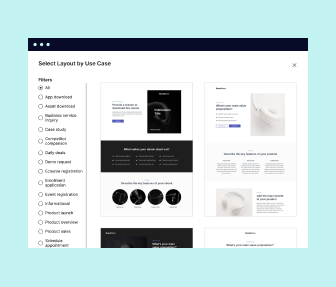
Multiple layouts for any industry and goal
Select from 500+ landing page layouts built to boost conversions across industry-specific scenarios. Customize them by adjusting fonts, adding images, and generating on-brand content with the AI assistant. Quickly scale with Instablocks® and Global Blocks that you can save, reuse, and update globally.
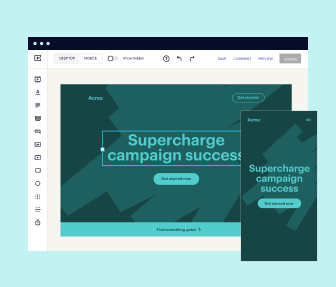
Loads fast and looks polished on any device
Every template is responsive, which means they present professionally on any device and load blazingly fast with our Thor Render Engine. You can also power them up with Google AMP technology to deliver an unparalleled mobile experience and drive higher conversions.
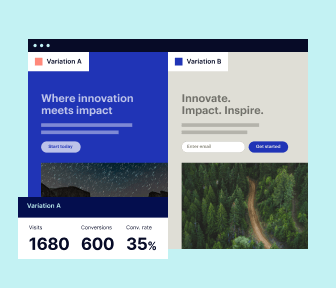
Robust analytics & experimentation
Get real-time updates and reporting across all your devices, showing the number of visitors, conversions, cost-per-visitor, and cost-per-lead. Launch AI-powered experiments, run A/B tests, and use heatmaps to analyze user behavior, then optimize your landing page to maximize conversions.

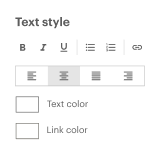
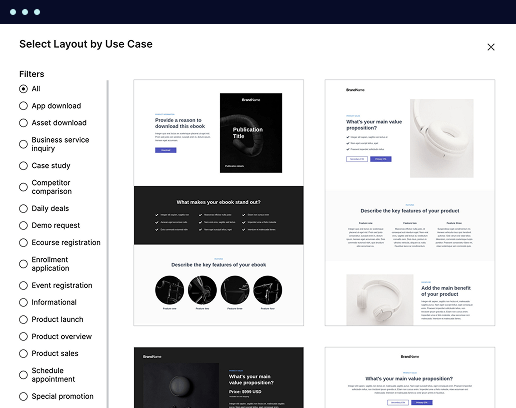
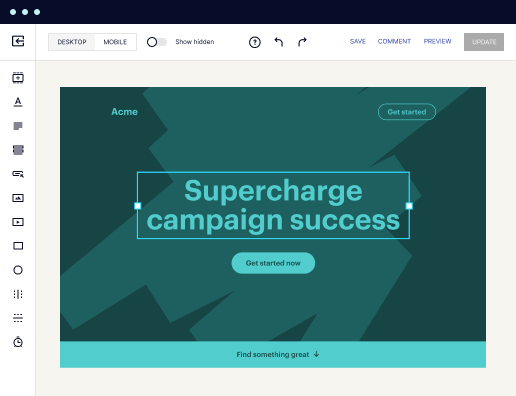
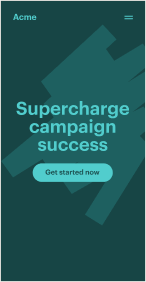
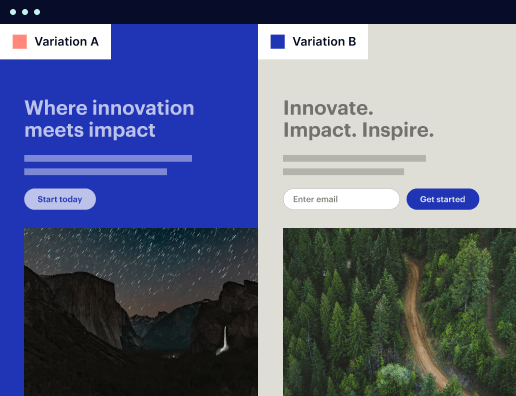

Easy to build without coding
With the intuitive drag-and-drop builder, anyone on your team can create high-converting pages without any knowledge of code or design. Make enhancements to your landing page with custom widgets using Javascript, HTML/CSS, or third-party scripts.
Multiple layouts for any industry and goal
Select from 500+ landing page layouts built to boost conversions across industry-specific scenarios. Customize them by adjusting fonts, adding images, and generating on-brand content with the AI assistant. Quickly scale with Instablocks® and Global Blocks that you can save, reuse, and update globally.
Loads fast and looks polished on any device
Every template is responsive, which means they present professionally on any device and load blazingly fast with our Thor Render Engine.
Robust analytics & experimentation
Get real-time updates and reporting across all your devices, showing the number of visitors, conversions, cost-per-visitor, and cost-per-lead. Launch AI-powered experiments, run A/B tests, and use heatmaps to analyze user behavior, then optimize your landing page to maximize conversions.
All the features you need to build lead-generating landing pages
Explore more featuresLearn how to build top-performing landing pages for any goal
FAQs
Leading the way in building high-performing landing pages





Maximizing ROI with Instapage: Your Guide to Landing Page Success
Creating high-converting landing pages has never been more critical in today's marketing landscape. With Instapage, you have access to an all-in-one landing page and CRO platform that not only optimizes but also accelerates your digital campaigns. This guide will walk you through the steps to effectively use Instapage, ensuring you capture leads and drive substantial ROI.
Why landing page optimization matters
Landing page optimization is essential for bolstering your marketing strategy. By utilizing Instapage's powerful tools, marketers can easily create conversion-focused pages. Higher conversion rates lead to better lead generation and ultimately more sales, as your audience finds exactly what they need without distractions.
- Increased conversion rates: Instapage's templates have proven success in converting visitors into leads.
- Streamlined A/B testing: With built-in experimentation features, you can refine your approaches based on real data.
- Customizable designs: Instapage allows tailored experiences for various audience segments, enhancing user engagement.
Step 1: Utilize Effective Templates
Selecting the right template is crucial to your landing page’s success. Instapage offers over 100 high-converting layouts and lead generation elements. Grab your audience's attention with visually appealing designs that guide them toward taking action while maintaining brand consistency.
Step 2: Implement A/B Testing
Conducting A/B tests helps you understand what resonates with your audience. Utilize detailed analytics tools to measure performance based on important metrics, such as click-through rates and conversion ratios, allowing for informed decisions.
- Test headlines: Experiment with different headlines to see which grabs the most attention.
- Call-to-action variations: Adjusting CTAs can significantly impact user behavior.
- Visual elements: Test changes in images, colors, or layouts to see which combination offers the best results.
Step 3: Optimize for Personalization
Personalizing landing pages is a game changer. Instapage allows for dynamic text replacement and audience-specific metrics, which help tailor the user experience. By aligning ads with specific landing pages using AdMaps, you ensure that visitors find what they are looking for, significantly increasing the likelihood of conversion.
- Dynamic content delivery: Create unique experiences based on user characteristics.
- Real-time analytics: Gauge how different segments are interacting with your content.
- Adaptive designs: Adjust layouts automatically based on user behavior patterns.
By following these steps to maximize the power of Instapage, you are well on your way to significantly improving your marketing results. Landing page optimization is not a one-time event but an ongoing process of learning and adapting.
Ready to transform your landing pages and boost your ROI? Start building high-converting pages today with Instapage!
People also ask about Next.js optimized unauthorized page template
Next.js optimized unauthorized page template
Understanding unauthorized pages in Next.js applications
Unauthorized pages in web applications, specifically in Next.js, refer to those that respond to user requests for resources they are not permitted to access. These usually return a 403 Forbidden status. Unlike a 404 Not Found error, which indicates that the requested resource cannot be located, a 403 error signifies that the server did understand the request but refuses to authorize access. As such, unauthorized pages play a crucial role in improving security by limiting access to sensitive information or functionality.
Creating effective unauthorized pages ensures that users are informed of their access limitations while guiding them on what to do next. This is an important differentiation from a 404 page since a 403 error communicates a more specific problem: the user is authenticated but lacks the permissions to view particular content. This context needs to be communicated clearly to preserve the user experience.
Optimizing unauthorized pages is vital. It enhances user experience significantly; rather than leaving users feeling confused or frustrated, a well-designed page politely informs them about access limitations and possible next steps. Additionally, maintaining brand integrity during error handling helps ensure that users perceive the brand positively even when faced with access issues.
Key features of an optimized unauthorized page template
An optimized unauthorized page template should prioritize a customized user experience. Creating a friendly atmosphere is essential when users realize they cannot access certain resources. To achieve this, messaging should be clear and positive, avoiding language that could exacerbate user frustration. Implementing clear navigation options encourages users to explore other accessible areas of the website. Furthermore, design elements play a significant role in fostering a sense of confidence and understanding. Subtle visual cues such as brand-appropriate colors, intuitive icons, and professional typography can make a user feel at ease, even when encountering limitations.
Dynamic content rendering is another vital feature. By leveraging the concept of `props`, content can be customized based on the user's specific context, ensuring that the unauthorized message is relevant. For instance, the response might differ for logged-in versus logged-out users. Additionally, user roles and permissions can influence the details of the messaging, allowing for context-aware language that resonates better with different audiences.
Customized user experience ensuring friendly, positive communication.
Dynamic content rendering tailored to user context.
Effective use of access controls for seamless context-driven experiences.
Technical implementation in Next.js
Setting up the unauthorized page template in Next.js involves creating a structured hierarchy within the pages directory. This ensures that the unauthorized page can be effectively managed and easily accessed. Developers can create a dedicated unauthorized page file, which can be enriched with distinct styles and functionalities. Utilizing Higher Order Components (HOCs) for access management can further streamline the process, making it easier to manage authentication states across an application.
Handling API responses and routing is crucial as well. In scenarios where unauthorized access occurs due to failed API calls, implementing custom error handling logic becomes necessary. For instance, the application can maintain a consistent messaging strategy that informs users about their access limitations. In conjunction, using Next.js routing capabilities ensures users are redirected appropriately, creating a more intuitive user experience that guides them towards resolving access issues.
Create and structure the unauthorized page file within the Next.js pages directory.
Employ Higher Order Components to manage access and routing seamlessly.
Utilize custom error handling to manage responses from APIs effectively.
Enhancing usability with previews and pre-rendering
Implementing Static Site Generation (SSG) can significantly benefit unauthorized pages in Next.js. SSG allows for rapid page loading, improving overall performance and user experience, especially for static content. Since unauthorized pages typically do not change frequently, leveraging SSG means that users will always receive quick access to relevant information without unnecessary loading delays. This is especially important for maintaining user trust and satisfaction even in restrictive situations.
Moreover, dynamic previews provide users with insights about access issues without needing deep diving into backend data. This can be achieved by manipulating URLs to reflect different access scenarios, making it easy for users to understand potential obstacles they may encounter based on their roles or attempts. By providing this functionality, you create a more transparent environment, encouraging users to explore and engage with the application without feeling misled.
Utilize SSG for faster page loads and improved user experience.
Create dynamic previews to offer users insights into access-related issues.
Leverage URL manipulations to showcase accessibility scenarios.
Integrating with user and team-based access control
Collaboration across different teams and technologies is crucial in developing an effective unauthorized page template. Each team's input adds richness to the development process, especially when web applications are complex and involve multiple user roles. Cross-functional collaboration can ensure that user needs are met while integrating feedback from marketing or legal perspectives. Tools for facilitating team workflows, such as Trello or Slack, can enhance communications and streamline efforts.
Additionally, implementing local and global location settings is vital for access control insights. As users may operate from varying locations, context-sensitive messages based on geolocation can enhance user understanding of access limitations. By factoring in local nuances, users can receive messages that are both relevant and comforting, potentially mitigating frustrations around access issues.
Foster cross-team collaboration for a well-rounded design approach.
Utilize tools like Trello or Slack for efficient communication between teams.
Implement geolocation features for tailored messaging based on user location.
Engaging users through knowledge and community insights
Fostering community feedback and questions is an essential strategy to enhance user experience around unauthorized access issues. Building a knowledge repository helps users to quickly find answers for common queries related to access limitations. A dedicated Q&A section allows users to share their challenges and frustrations and seek peer-driven support. This collaborative approach not only provides valuable insights to users but also strengthens community ties.
Additionally, creating collectives for user interaction enhances the knowledge exchange process. Through forums or discussion boards, users can share experiences and insights that open up dialogue regarding access issues. Establishing moderation strategies ensures that conversations remain productive and that users receive accurate information. This sense of community empowers users, making them feel part of the solution rather than isolated by limitations.
Create a knowledge repository to address common access-related concerns.
Implement a Q&A section to allow community-driven support.
Establish collectives for sharing user experiences with access issues.
Exploring questions and best practices
Addressing common user questions about unauthorized page access helps clarify frequent issues. Curating a list of frequently asked questions can provide users with immediate support. Typical inquiries may include why they are receiving a 403 error, how to obtain proper access, or ways to troubleshoot potential authorization issues. Providing succinct answers mitigates user frustrations and aids them in understanding their access limitations.
In addition to user questions, sharing best practices for maintenance and optimization of unauthorized pages is crucial. Regular checks ensure template efficiency, helping to identify any broken links or outdated information. Metrics that track user engagement with unauthorized pages can offer insights into areas needing improvement, ensuring a responsive and user-centric design approach is consistently upheld.
Curate FAQs to address common user inquiries around access.
Perform routine checks to maintain the effectiveness of the template.
Analyze user engagement metrics to identify optimization opportunities.
Case studies and success stories
Examining notable implementations of unauthorized page templates in Next.js provides valuable insights into successful designs and strategies. Successful examples demonstrate how brands have meticulously crafted unauthorized pages that maintain a professional tone while guiding the user experience. By showcasing contrasts in user feedback or analytics results, these implementations highlight the real-world efficacy of well-structured unauthorized pages.
Furthermore, studying lessons learned from community experiences emphasizes the evolution of best practices. Developers may face hurdles, such as poor user reception to an unauthorized page template. However, through collaboration and open discussions, many have generated innovative solutions that streamline the user experience. These shared experiences cultivate a learning environment, enabling developers to refine approaches and deliver optimal unauthorized page experiences.
Showcase successful unauthorized page designs from notable brands.
Analyze user feedback to measure the effectiveness of these designs.
Share lessons from community experiences to enhance future developments.
Future directions and innovations
Given the rapid pace of technological advancements, anticipating trends in unauthorized page design is essential for staying ahead. Upcoming technologies may usher in sophisticated analytics and user engagement features, enabling a more tailored experience when users encounter unauthorized access issues. For instance, integrating artificial intelligence could empower these pages to offer real-time suggestions on how users can obtain appropriate access or navigate similar issues more effectively.
The role of user feedback in continuous improvements cannot be overstated. Establishing numerous channels for collecting feedback ensures that user engagement remains at the forefront of design considerations. By iteratively refining unauthorized pages based on user input, brands can ensure they meet evolving expectations and deliver intuitive experiences that foster trust and loyalty.
Anticipate upcoming trends in unauthorized page design and technology integration.
Monitor user feedback channels for ongoing improvements.
Iteratively refine unauthorized pages to enhance user experience.
Ready to skyrocket conversions?
Supercharge your ad campaigns with high-performing landing pages
Get started